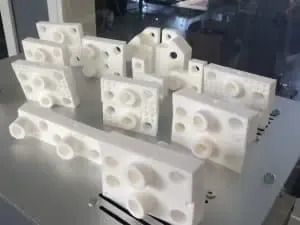In the last few years, 3D printing has become one of the most effective and frequently chosen solutions for producing replacement parts, device enclosures, and even specialized prostheses. When looking for a solution that will allow you to create a small number of elements at a low cost, customers are increasingly opting for 3D printing.
However, behind the term 3D printing, there are several competing technologies. The most prominent ones in commercial applications are powder solutions – MJF and SLS.
How are the two technologies different, and what are the business benefits for companies that choose them?
Additive powder technologies in 3D printing
Both HP MJF (HP Multi Jet Fusion) and SLS (Selective Laser Sintering) are competing technologies that use plastic powder (polyamide) to print parts, which in both cases is sintered differently.
SLS, as can be deduced from the name Selective Laser Sintering, uses to sinter the powder. Layer by layer, the printer applies millimeters of powder, which the laser hardens to create the desired shape. This technology dates back to the 1980s, long before 3D printing was widely used in production. Nowadays, after many improvements, it is still used in many industries.
MJF, the Multi Jet Fusion technology developed by HP, also uses powder for printing, but in this case, the powder is sintered using a binding agent and sintering lamps. The first HP MJF printers were introduced in 2016 as devices adapted to the needs of modern, agile enterprises.
Apart from all the key characteristics of additive technologies, both technologies share several key features:
- They are based on polyamide sintering
- They do not require support structures.
- Elements created by them have similar density
- Similar workflow.
But here’s where similarities end. MJF 3D printers, being much more modern devices, have several significant advantages, although, in some respects, they still give way to the older SLS technology. So what exactly are we talking about?
Key differences between MJF and SLS technologies
1. Interchangeable working chamber (MJF)
After the printing process is completed in most SLS printers, the components inside the chamber must cool down before starting the next printing. This cooling could take up to twice as long as the printing itself. It increases the project implementation time significantly. For MJF printers, a removable chamber is standard. This allows the printer to run all the time, making it possible to deliver last-minute projects. This solution was introduced only in the latest SLS printers.
2. Different methods of powder sintering
In the case of SLS technology, a laser surrounded by nitrogen is used for sintering, which is fed through a generator, so the chamber itself must be additionally sealed.
This significantly extended the time needed to prepare the printer. Laser sintering can take up to 7 hours to reach the correct temperature and create a nitrogen-only chamber.
MJF uses a special ink for this, which does not require such specific conditions, additional time, and additional devices that can potentially be susceptible to faults and changing conditions. Preparing the printer for operation takes only 40 minutes. In practice, this means that we can verify the correctness of print much faster and deliver ready-made projects.
One of our clients, wanting to test the possibilities of both competing solutions, ordered elements from us and a company that operated in SLS technology. When we received the order on Friday, we were able to start printing the same day and have the items ready on Sunday. Due to the necessary time to prepare the printer, our competitors could not begin processing the order until Monday.
3. Wider color palette (SLS)
SLS prints are white and can be colored according to preference. In the case of MJF, the selection is limited to dark colors such as the ones below:

4. Better water resistance (MJF)
Porosity is another disadvantage of 3D printing with SLS technology. Due to the point sintering and lower tightness, the elements absorb water more than those made in MJF. Water resistance was essential for one of our customers who had previously used SLS technology. However, the printed elements lost their properties after being exposed to water for a long time. With MJF elements, it wasn’t an issue.
5. Possibility of medical applications
Both the elements created in MJF and SLS can be used for prostheses (skin contact) or device enclosures in medicine, but there is a minimal advantage on the SLS side. Due to the use of pure PA12 material (filament), laser sintered devices can be used for tools that come into direct contact with internal tissue.
6. Smoother Surfaces and Strength (MJF)
Due to less visible print layers and more aesthetic edges, MJF printing provides a much better visual effect. Thanks to this, it is better for all kinds of enclosures and other elements for which appearance matters.
In addition, our EU-project study found that MJF has no difference in strength between the x, y, and z axes. In most additive technologies, including SLS, the z-axis is a problem due to layer sticking.
In one of the projects, our client had the opportunity to see how important it can be. The element created in the SLS printer tended to break after quite a short time. After being produced in the MJF printer, this problem was eliminated.
7. Greater precision and repeatability of printing (MJF)
Another characteristic that our customers often pay attention to is the better repeatability of printing compared to previous orders in SLS technology. In the case of all 3D printing technologies, you have to consider minimal differences in the dimensions of the printed elements, but MJF printers are more reliable in this respect. Proper handling can achieve a tolerance of +/- 0.2 mm. Moreover, the printed models are characterized by the same deviation for a given detail, regardless of its position in the chamber. This means that each detail in the series will have minus dimensions. And this allows you to predict the allowance for subsequent machining or processes.
8. Ecological and economic aspect (MJF)
HP Multi Jet Fusion devices use only 20% of new powder in the printing process, while the remaining 80% is at least once used material. In the case of SLS technology, it is a 50/50 division. This makes a massive difference in terms of both cost and material consumption.
MJF – a response to the needs of modern production
When we bought the first Multi Jet Fusion printer for Cubic Inch in 2018, we were the first such company in Poland. Since then, we have completed nearly 2,500 projects in various industries and bought two more printers.
There is no doubt that with the rapidly growing popularity of this technology, we can also expect more and more improvements, and therefore:
- lower costs,
- even better durability,
- and a wider range of colors.
If you feel that 3D printing can be used in your company, arrange a consultation with our experts, and we will help you take full advantage of the HP Multi Jet Fusion technology.


